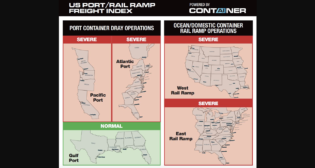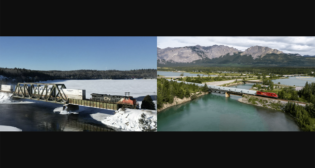
Crude by rail: The outlook is good
Written by William C. Vantuono, Editor-in-Chief“The couple of years when a significant arbitrage existed unveiled to shippers the many benefits of using the railroads to move crude,” Seidl says in his most recent Equity Research analysis. “The result is that many shippers now appear convinced that rail should continue to be an important transportation option regardless of the arbitrage or the lack thereof. That said, the narrow price differentials are putting a damper on spot crude shipments on rail in the near term, especially in geographies of greater and growing pipeline capacity, such as from the Bakken to the Gulf.
“The East and West have limited pipeline options, and that is likely to remain the case in the foreseeable future. Producers have slightly shifted back to pipeline but remain committed to rail long-term. In June, the North Dakota Pipeline Authority estimated that 68% of crude was exported from the Williston Basin by rail, down from 75% in April. This is mostly due to companies taking advantage of the shifts in oil price differentials. Oil production in the basin is now about 900,000 bbl. per day (June) and could reach 1.80 million bpd by year-end 2018. While sufficient pipeline capacity is expected to come online by 2016 (about 1.6 million bpd), we think rail volumes will continue to grow moderately over the next few years despite pipelines taking back some market-share, mostly Gulf Coast destinations. We note the all-in cost of rail remains competitive with pipeline options, without having to make long-term volume commitments, a positive for oil producers.
“From a refiner perspective, the outlook for CBR has been impacted by the compression of the Brent/WTIspread. While this does represent a strain on the CBR system in the near term, we note factors that in our view render the current differential levels transitory, as well as highlight certain routes that remain in the money and should see continued growth with North American production volume increases.
“From a producer perspective, rail is still playing a large factor in oil transport logistics. Our thesis regarding long term optionality with the oil and gas producers remains largely unchanged. Operators may have tempered back shipments on rail due to slightly higher net-back on new pipeline capacity, however we think operators will remain flexible. Operators will be reluctant to overly commit to one or the other over the next few years, with a combination of the two being the most advantageous. Pipelines likely will be the most cost effective over the long term, especially to the Gulf, however rail should provide welcome optionality, mostly to East and West markets. Optionalit, always wins for an oil producer. While always sending crude to the most economic market is ideal, in our view, a slightly lower realization at the expense of possible shut-in production would be the more realistic decision. Limiting yourself to only one market significantly increases marketing risk. We think reducing this risk is worth scarifying a few $/bbl on the realization.”



